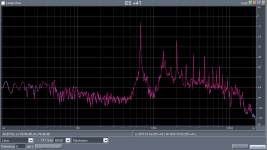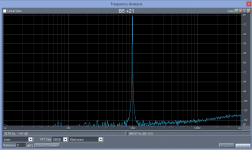Two 3/5's and a 5/8.
The spectrum of these looks very similar to me, at least in the part that matters, although when listening I felt that one of them had a more 'consistent' amplitude overtone than the other. I used Philips earbuds this time on the laptop. Your previous sine test was using the inbuilt speakers.
The ABX result shows I couldn't reliably pick between these last two though.
I can post the spectrum image or would that spoil things ?
I suspect that looking over a long sample period masks what is happening real time though, the overtone was more 'morse codish' 😀 in one of them vs the other... or so I thought.
(You might find this fun. Try and capture a recording of a note after it has been tuned and look at the spectrum and frequency of the fundamentals. Even Audacity does a pretty good job here. There is a timeline description of the tasks below the video.
Tuning a Steinway)
The spectrum of these looks very similar to me, at least in the part that matters, although when listening I felt that one of them had a more 'consistent' amplitude overtone than the other. I used Philips earbuds this time on the laptop. Your previous sine test was using the inbuilt speakers.
The ABX result shows I couldn't reliably pick between these last two though.
I can post the spectrum image or would that spoil things ?
I suspect that looking over a long sample period masks what is happening real time though, the overtone was more 'morse codish' 😀 in one of them vs the other... or so I thought.
(You might find this fun. Try and capture a recording of a note after it has been tuned and look at the spectrum and frequency of the fundamentals. Even Audacity does a pretty good job here. There is a timeline description of the tasks below the video.
Tuning a Steinway)
Hi Karl, thanks for trying the files, no problem to post the spectra, as this is not a poll question. Spectra differ in even harmonics (which are lower than odd harmonics for this type of flute). When exploring spectra, please bear in mind it must be the same part of the music samples.
Yes, there is some difference in infrasound area 😀 (H2 makes DC...). The best way is to put both files into CoolEdit and to switch between spectra with cursor position at the same sample. When I make a stereo track from both files, the spectra are almost indistinguishable.
I made this small test to show that though it is quite easy to tell the sound difference on the pure sine tone, it is not so even on a single tone of a relatively spectrally simple instrument like the recorder flute is.
I made this small test to show that though it is quite easy to tell the sound difference on the pure sine tone, it is not so even on a single tone of a relatively spectrally simple instrument like the recorder flute is.
Attachments
Last edited:
Listening on chromebook with Grado SR80, I think apricot is the original and I prefer it. Concentrating primarily where the bass and kick drum come in, they sound more defined on apricot.
Listening on chromebook with Grado SR80, I think apricot is the original and I prefer it. Concentrating primarily where the bass and kick drum come in, they sound more defined on apricot.
Thank you for your comments. Tomorrow we will have a disclosure.
Listening on chromebook with Grado SR80, I think apricot is the original and I prefer it. Concentrating primarily where the bass and kick drum come in, they sound more defined on apricot.
Soft player?
Direct Sound, WASAPI, ASIO, Kernel Streaming... ?
Chromebook -> must be ALSA.
By the way, in my Linux the sound is worse than in my W10 very optimized to play multimedia.
Last edited:
I think the soft player is a very interesting data.
With JRMC 64 bits and Kernel Streaming the best was Apricot.
Can you tell original file from tube amp record? - test
With foobar2000 and Kernel Streaming Avocado sounded a little better.
Can you tell original file from tube amp record? - test
I only trust, in my system, in JRMC 64 bits.
With JRMC 64 bits and Kernel Streaming the best was Apricot.
Can you tell original file from tube amp record? - test
With foobar2000 and Kernel Streaming Avocado sounded a little better.
Can you tell original file from tube amp record? - test
I only trust, in my system, in JRMC 64 bits.
So all those people 'upgrading' the crystal osc in their CD players should actually be reducing the draughts and eddy currents in the air in their listening room? And they should definitely avoid any hint of open-air concerts?scott wurcer said:It has been shown that the air in a properly conditioned and ventilated listening space is not stationary for the propagation of sound at the level of even an ordinary crystal oscillator.
So all those people 'upgrading' the crystal osc in their CD players should actually be reducing the draughts and eddy currents in the air in their listening room? And they should definitely avoid any hint of open-air concerts?
From Dave Griesinger again, this is a music venue and I assume a home is better (Ed's much better). But it's a long way to pico-seconds.
With a sample rate of 44.1KHz these random walks produce a maximum pitch-shift of .04%. The mean absolute value of all 32 walks is 8 samples, 2.4 inches per second, or 0.13 miles per hour.
i tried the sine and flutes and absolutely cannot tell them apart! so my next try will involve some scotch...
i tried the sine and flutes and absolutely cannot tell them apart! so my next try will involve some scotch...
Regarding flute, it is no surprise, but sine should be quite easy. There is a necessary condition, or two conditions.
1) the speaker or headphone used must have lower distortion than the distorted wave (I assume soundcard is not a total cr.p)
2) the listening level must be low, otherwise intrinsic human ear distortion masks the signal distortion
The distorted sine has 0.64% THD spectrum attached.
Regarding flute, the amp added distortion is masked by the flute spectrum and IMO it cannot be audible be ear, in a DBT.
Attachments
ok i went back to the "fruit" files i'm better then guessing, no?(and that's no scotch!)
Attachments
Last edited:
sorry to me both the flute and sine files are distorted sines and i can hear no difference (i started thinking they're identical files)
Yes, you already had 10/16 before.
Regarding the sine test, I find it easy with "middle-class" headphones or speakers with low distortion. On my notebook internal speakers it is impossible to tell.
Regarding the sine test, I find it easy with "middle-class" headphones or speakers with low distortion. On my notebook internal speakers it is impossible to tell.
sorry to me both the flute and sine files are distorted sines and i can hear no difference (i started thinking they're identical files)
Sine original file has no distortion at all. It is your system or ears that make a distortion. I would suggest more humbleness in your judgement. Your system or your ears are fooling you, do not trust them blindly.
Mooly had 8/8 in the sine test, as an independent listener.
Attachments
Something off topic but...
kernel streaming vs asio vs wasapi vs direct sound - Google Search
In the next test people should to say what soft player and output sound mode.
Windows: should you use DirectSound(default), WASAPI or ASIO - Xylio
kernel streaming vs asio vs wasapi vs direct sound - Google Search
In the next test people should to say what soft player and output sound mode.
Windows: should you use DirectSound(default), WASAPI or ASIO - Xylio
- Home
- General Interest
- Everything Else
- Can you tell original file from tube amp record? - test



